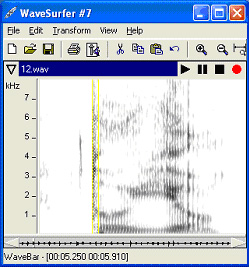Michael Fraas - michael.fraas@unh.edu
Dept. of Commun. Sci. and Disord.
Univ. of New Hampshire
Durham, NH 03824
Popular version of paper 2aSC14
Presented Tuesday morning, May 25, 2004
147th ASA Meeting, New York, NY
Approximately 13% of the U.S. population are Spanish speaking (US Census Bureau 2000). A large proportion of these speak Spanish as their primary language, but when they have a speech disorder, they are usually serviced by English-speaking professionals. This is particularly true for medical conditions that result in degraded speech production, such as Parkinson's disease. Further, Spanish and English use slightly different pronunciations for the "same" sound-that is, an English 'b' and a Spanish 'b' are different. This sets up a difficult problem: The patient wants to become more intelligible in Spanish, but the English-speaking clinician may not hear the differences between English and Spanish pronunciation, and may not know how to alter therapy to improve intelligibility in Spanish as opposed to English. Further, although there have been many studies of the way Parkinson's disease affects speech production in English speakers, we know very little about the way it affects speech production in Spanish speakers. Thus, the English speaking clinician may not know which features of pronunciation are attributable to the disease, and which features of pronunciation are attributable to the difference between English and Spanish.
One aspect of pronunciation that is known to differ between English and Spanish speakers affects the production of stop consonants 'p,' 't,' 'k,' 'b,' 'd,' 'g'. These consonants are used in both English and Spanish, but with different patterns of speech timing. In fact, the way Spanish speakers produce 'p,' 't' and 'k' at the beginnings of words sounds like 'b,' 'd' and 'g' to English-speaking ears. Thus, a Spanish word such as "paño" will sound to an English ear like "baño. These differences can be shown acoustically using a measure known as Voice Onset Time (VOT). (It is a measure of the amount of time that elapses between when a stop consonant is released and when the larynx begins to vibrate.) In contrast, the English way of producing of 'p,' 't' and 'k' at the beginnings of words has a much longer VOT. The English timing pattern for 'p,' 't,' and 'k' sounds very distorted in Spanish.
This aspect of pronunciation-i.e. VOT-is also affected as a result of Parkinson's Disease. In general, Parkinson's Disease is a movement disorder, and the result of slow and effortful tongue, lip and jaw movements is that speech timing patterns are distorted. Patients with moderate and severe Parkinson's disease are typically somewhat unintelligible, and it has been shown that some of this unintelligibility can be attributed to abnormal patterns of VOT. In particular, it has been shown that English-speaking Parkinson's Disease patients produce words beginning with stop consonants such as 'p,' 't,' and 'k' are with extra-long VOT's.
This study had two aims: (1) we wanted to document voice onset time differences
in the speech of native Spanish speakers free of neurological disease vs. native
Spanish speakers with a diagnosis of Parkinson's disease (PD), (2) and explore
the different ways in which English and Spanish-speaking listeners perceive
voicing distinctions in the speech of these groups.
To investigate the perception of speech characteristics of Parkinson's disease in Spanish speakers by English-speaking listeners, speech samples were collected from a group of 24 native Spanish speakers belonging to a Parkinson's support group in El Paso, TX. Eleven of the speakers were diagnosed with Parkinson's disease the remainders were spouses or caregivers who served as controls for the study. The speech samples used for this study consisted of minimal pair contrasts, pairs of words that differed by only one sound (ex. "paño" and "baño").
The recordings were played to two groups of judges; group one consisted of 21 native English-speaking graduate students in Communication Sciences and Disorders, a program that trains students to be Speech-language pathologists; the second group consisted of 6 native Spanish-speaking professionals.
In the perception of Spanish speech, it was found that the English speaking
graduate students erroneously judged production of words beginning with 'p,'
't,' and 'k' by normal Spanish speaking controls as words beginning with 'b,'
'd,' and 'g'. Similarly, this same group of judges perceived production of the
same words by Parkinson's speakers accurately. This indicates that the initial
sounds of each word were produced by the Parkinson's speakers in a manner similar
to how a normal English speaker would produce the same type of sounds. However,
this production is inaccurate for the group and indicates that they are producing
speech that is disordered compared to their normal Spanish-speaking counterparts.
The native Spanish-speaking judges did not make the same erroneous judgments.
The implications of this suggest that if an English-speaking SLP were to evaluate
a Spanish-speaking patient with Parkinson's disease for speech therapy, they
would potentially misdiagnose the problems of the speakers and subsequently
develop an inappropriate treatment plan for managing the patient's deficits.
It is hoped that these results can be utilized by speech-language pathologists,
both native Spanish-speaking and native English-speaking, to develop remediation
strategies that are more efficacious and relevant to the Spanish speaker with
a speech disorder.
| Comparison of t-initial word produced by a normal Spanish-speaking Male and a Spanish-speaking male with Parkinson's disease | |
 |
 |
Figure 1: demonstrates the difference in production time for initial
/t/ in the word "tuyo." A Spanish-speaking male with Parkinson's disease
produced the figure on the left with duration of 60ms. A normal Spanish-speaking
male produced the production on the right with duration of 20ms.
References:
United States Census Bureau (2000). U.S. Census Bureau Guidance on the
Presentation and Comparison of Race and Hispanic Origin Data.
National Institute on Neurological Disease and Stroke (2003). Incidence of Parkinson's
Disease: Variation by Age, Gender, and Race/Ethnicity. Am. J. Epidemiology.
157: 1015-1022.